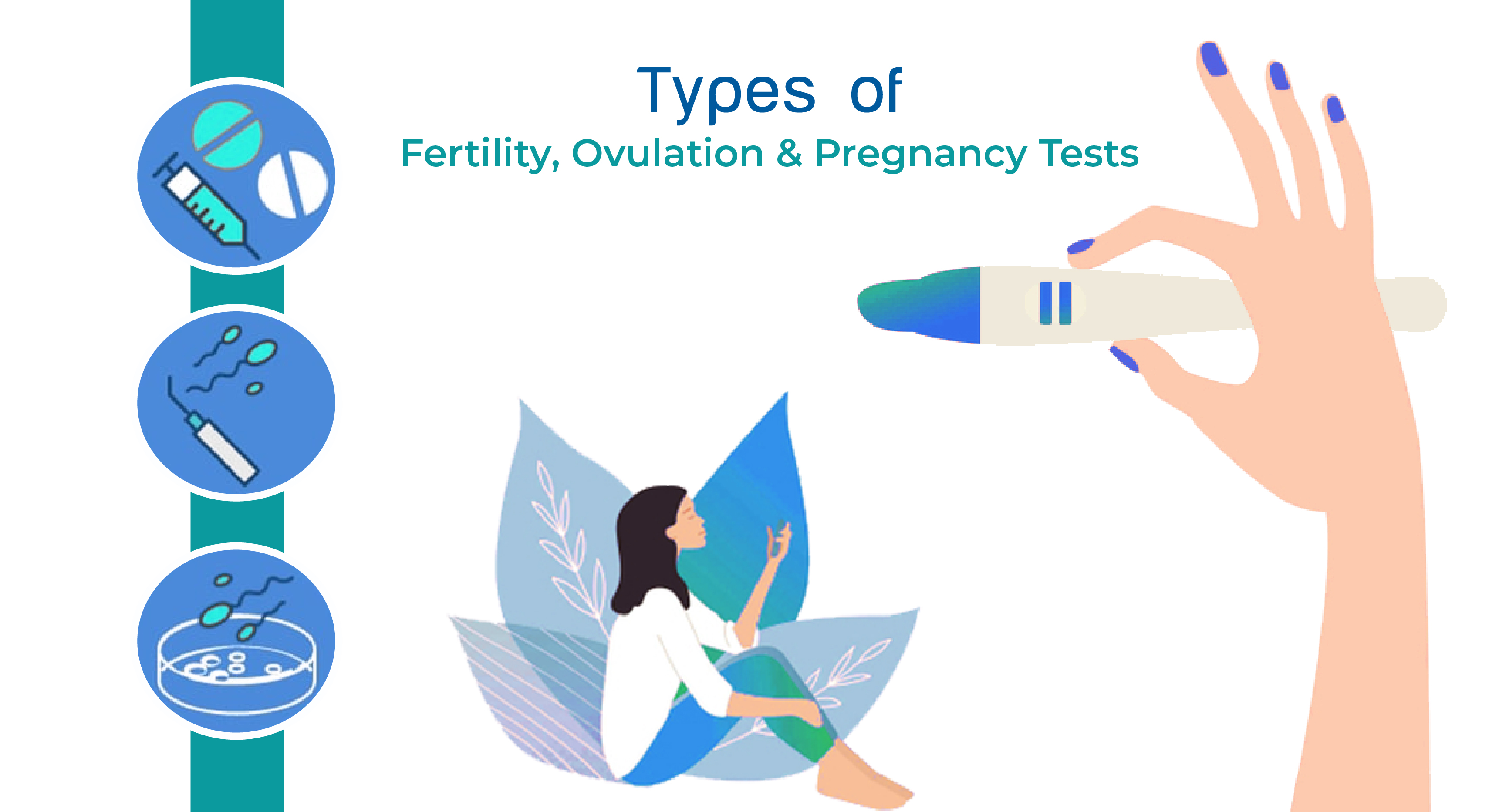Every woman goes through different types of hormonal changes throughout her life. As per the Gynecologists, from childhood to first menstrual to conception to childbirth to menopause, sometimes even after menopause, women have generally undergone different phases of hormonal changes. Throughout this blog, the various tests you will be reading out, almost all of them determine the result through hormones only.
Fertility Tests
It is possible that a woman can be curious about her fertility or might be trying to conceive but won't be getting any success. These tests are often the first step in fertility treatment. Gynecologists can perform simpler fertility tests while a reproductive endocrinologist can perform thorough fertility testing. There are many fertility tests available today, not every fertility test will be undertaken for every case. The more invasive fertility tests, like diagnostic laparoscopy, will only be done when symptoms or other tests point in that direction, or when a cause for infertility cannot be found otherwise. The different types of test are:
- Ovulation Test
The doctor will examine whether you are ovulating or not. In regular intervals, the doctor will check your basal body temperature as ovulation results in increased body temperature. The doctor might also test through ovulation prediction sticks, which are readily available in pharmacies. In a few cases, the doctor might even suggest a blood test for the same.
- Ovarian Function Test
This test confirms your ovarian reserve or the egg supply. The test indicates how your ovaries are functioning or if your ovulation is fine. There can be different ovarian function tests like third-day follicle-stimulating hormone (FSH), third-day estrogen level tests, and blood tests.
- Ultrasound
Through ultrasound, doctors can determine whether ovaries and uterus are performing well or not. In the case of the uterus, it determines the thickness of the uterine lining, while in the case of ovaries it checks if ovarian follicles are developing normally. The ovarian follicles are responsible for the secretion of hormones that trigger an egg's released during ovulation.
- Hormone Blood Tests
As mentioned in the introduction, a female's body produces different hormones during each phase of her life. Through these tests, it is checked whether her body produces all hormones related to the female reproductive cycle. The hormones tested in these tests include estrogen, progesterone, luteinizing hormone, testosterone, follicle-stimulating hormone, prolactin, inhibin B, and dehydroepiandrosterone (DHEA).
- Hysterosalpingogram (HSG)
The uterus and fallopian tubes are checked in this for blockages or any abnormalities. A dye is injected, and then an X-ray technician examines the uterus and fallopian tubes. This test shall be conducted between day 6 to day 14 of your cycle.
- Laparoscopy
In laparoscopy, a minor incision is made on the abdomen. Through it, a fiber-optic tube with a camera is inserted. This tube is called a laparoscope, and it provides a clear view of the uterus, ovaries, and fallopian tubes. The test is performed under general anesthesia. Doctors are generally sure when there is some abnormality or a definite chance of endometriosis when they suggest this procedure.
- Cervical Test
This test is for checking the amount of mucus in the cervix. The cervix secretes this mucus, and it provides the sperms with the necessary protection and nutrition to begin their journey to the egg. Through this test, it is determined whether mucus is more than the desired amount or if any harmful bacteria are present, or if the mucus is fertile or infertile. The hormone estrogen stimulates cervical mucus production, and this test is usually post-coital. After this, the doctor examines a sample of the woman’s cervical mucus under a microscope to check if the sperm can swim in the mucus
- Hysteroscopy
This is a procedure in which a thin tube with a camera called a hysteroscope is inserted in the cervix to enable the doctor to get a clear view of the inside of the uterus for checking abnormalities. Pictures can also be taken through a hysteroscope for later examination.
- Endometrial Biopsy
The tissue endometrium, which is present inside the lining of the uterus, a small piece of it is scrapped out for examination. This is done just before the woman's period. It is determined whether the tissue is thick enough for an egg to get implanted. When ovaries release an egg or are due to release, the endometrium in the uterus gets thicker to allow a fertilized egg to implant and grow into an embryo. The tissue is also crucial for pregnancy as it provides the required amount of nutrition and protection to the egg until the placenta is formed.
- Sonohysteroscopy
A common fertility test for women, which is also used as a substitute for a Hysterosalpingogram test. In this, the woman's uterus is filled with saline water, and through vaginal ultrasound, the inside of the uterus is checked for any abnormal growths and blockages.
Ovulation Tests
The final stage of egg maturation is called ovulation. The egg exits the ovary and enters the fallopian tube. Throughout this, the egg needs to be fertilized by sperm for conception, and eventually pregnancy. In the normal menstrual cycle, there are only 1-2 days in which conception is possible. Usually, the sperm survives for only 48 hours inside the female reproductive system, so it must meet the egg during this time.
- Ovulation Predictor Test
As maturation causes the release of LH and estrogen, this test detects the same through urine test (for LH- luteinizing hormone) or the rise of the hormone estrogen in saliva. The urinary test is considered more reliable and hence more commonly used. For a day, approximately 24-48 hours before ovulation, the hormone LH rises and falls. This is done as a signal for the egg release, and the body prepares for the same. Ovulation is predicted in this way through LH.
- Basal Body Temperature (BBT) Chart
Ovulation results in body temperature being risen by one and a half degrees Fahrenheit for two weeks. If there's no conception, then the temperature will drop to baseline at the time of menses, but during pregnancy, the temperature remains risen only. Measuring BBT allows one to confirm ovulation retrospectively.
- Ultrasound monitoring
After ovulation, the follicular cyst, a fluid-filled cavity that contains the egg, collapses. The collapse can be taken as evidence of ovulation, and daily ultrasounds can detect the same. However, this method is labor-intensive and expensive. Also, ovulation can occur even without follicular collapse. This why this method is not often used.
- Progesterone Level
Progesterone, a hormone responsible for egg formation, rises in the blood after ovulation until it reaches its peak in 7-10 days. So the high progesterone levels, when performed after 7-10 days of ovulation, confirm that ovulation has occurred and the progesterone production for that cycle is normal. The low progesterone level can be because of no ovulation or inadequate progesterone production.
- Endometrial Biopsy
As shared among one of the fertility tests, this test is conducted in the same manner as an ovulation test. Testing of endometrium tissue can determine whether ovulation has occurred and whether progesterone production is adequate. The test is to be done 7-10 days after ovulation. This test can be a bit painful and expensive, and also a single blood level of progesterone can provide similar information, so biopsies are infrequently performed as ovulation tests.
Pregnancy Tests
The pregnancy tests can be done from home as well as in a medical institution. A home pregnancy test (HPT) is used on the first day of periods being missed. Some tests are more sensitive and can be undertaken earlier. It may also differ if you have used birth control pills for a while. The home pregnancy tests can give false pregnancy alarms like showing a positive when you actually aren't. So, in any case, a checkup from the doctor is a must.
- Urine test
These tests can be taken at home as well as your doctor's office. They work by detecting the hormone human chorionic gonadotropin (hCG) in the urine. This hormone is only found in the body during pregnancy. In the HPT (home pregnancy test) the chemical in the stick changes color when it comes into contact with this hormone. Clinical urine tests aren't necessarily more accurate than an HPT.
However, a doctor may be able to help eliminate any possible errors that might affect the test's accuracy. Results of urine tests depend upon how you use the pregnancy test kit (in HPT) and the doctor you visit (in clinical test). Also, the HPT provides results in 10 minutes, while clinical test results come in a week. In the case of HPT, the test must be taken twice.
- Blood test
They are to be taken at a medical facility under the guidance of a doctor. There are two types of pregnancy blood tests, and both detect the hCG.
Qualitative hCG blood test: This is to check whether hCG is being produced in the body and provides a simple yes/no answer.
Quantitative hCG blood test: As the name suggests, it is for determining the specific level of hCG in the blood.
As per the difference in hCG levels concerning normal levels and your opinion regarding how far you are in your pregnancy, the doctor might suggest an ultrasound or a second hCG test in a couple of days. Your opinion regarding pregnancy might be based on your dates.
The quantitative hCG blood tests are highly accurate because they measure the exact amount of hCG in the blood. They even detect smaller amounts of the hormone, which are often missed in a qualitative hCG blood test or a urine test. Lastly, the blood test is more expensive than the urine test, and the wait is also longer.
These are the types of tests a woman can take for fertility, ovulation, and pregnancy. Usually, fertility and ovulation test aren't required, but to increase the chances of conception by planning the coitus on the right days, a woman might use an ovulation test. A fertility test is recommended when women fail to conceive for one year (if below 40) or six months (40 or above). The tests shall be taken under the guidance and supervision of an expert and experienced fertility doctor, gynecologist, or such experts.



 IVF Centers
IVF Centers IVF Doctors
IVF Doctors Joint Replacement
Joint Replacement Spine Surgeries
Spine Surgeries Dental
Dental Slimming/Weight Loss Clinics
Slimming/Weight Loss Clinics Hair Transplant Clinics
Hair Transplant Clinics Physiotherapy clinics
Physiotherapy clinics
 Search
Search





